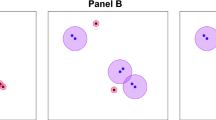Abstract
We consider an interacting particle system onZ dto model an epidemic. Each site ofZ dcan be in either one of three states: empty, healthy or infected. Healthy and infected individuals give birth at different rates to healthy individuals on empty sites. Healthy individuals get infected by infected individuals. Infected and healthy individuals die at different rates. We prove that in dimension 1 and with nearest-neighbor interactions the epidemic may persist forever if and only if the rate at which infected individuals give birth to healthy individuals is high enough. This is in sharp contrast with models analysed by Andjel and Schinazi (1994) and Sato et al. (1994) where infected individuals do not give birth. We also show that some results in the latter reference can be obtained easily and rigorously using probabilistic coupling to the contact process.
Similar content being viewed by others
References
E. Andjel and R. Schinazi (1994). A complete convergence theorem for an epidemic model. Journal of Applied Probability, 1996
C. Bezuidenhout and G. Grimmett. The critical contact process dies out, Annals of Probability18 (1990) 1462–1482
C. Bezuidenhout and G. Grimmett. Exponential decay for suberitical contact and percolation processes. Annals of Probability19 (1991) 984–1009
M. Bramson and R. Durrett (1988). A simple proof of the stability criterion of Gray and Griffeath. Probability Theory and related fields,80, 293–298
R. Durrett. Oriented percolation in two dimensions. Annals of Probability12 (1984) 999–1040
R. Durrett (1988). Lecture notes on particle systems and percolation. Wadsworth
R. Durrett (1991). The contact process, 1974–1989. Lectures in Applied Mathematics,27, American Mathematical Society, Providence, RI
R. Durrett (1993). Ten lectures on particle systems. Saint-Flour Lecture Notes. Springer Lecture Notes in Mathematics, to appear
R. Durrett and C. Neuhauser. Epidemics with recovery inD = 2, Annals of Applied Probability1 (1991) 189–206
R. Durrett and R. Schinazi. Asymptotic critical value for a competition model, Annals of Applied Probability3 (1993) 1047–1066.
T. Harris (1972). Nearest neighbor Markov interaction processes on multidimensional lattices Adv. Math.,9, 66–89
T. Liggett (1985). Interacting particle systems. Springer Verlag, New York
T. Liggett (1994). Improved upper bounds for the contact process critical value. Preprint
K. Sato, H. Matsuda, A. Sasaki. Pathogen invasion and host extinction in lattice structured populations. J. Math. Biol. (1994)32, 251–268
Author information
Authors and Affiliations
Rights and permissions
About this article
Cite this article
Schinazi, R. On an interacting particle system modeling an epidemic. J. Math. Biol. 34, 915–925 (1996). https://doi.org/10.1007/BF01834826
Received:
Revised:
Issue Date:
DOI: https://doi.org/10.1007/BF01834826




